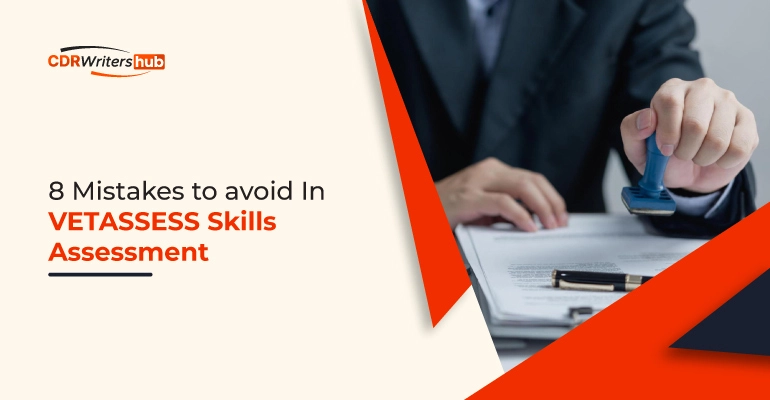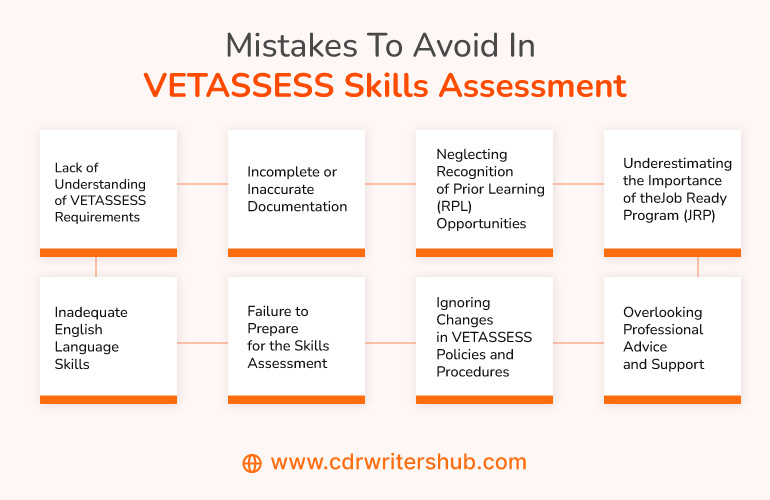8 Mistakes to Avoid in VETASSESS Skills Assessment

8 Mistakes to Avoid in VETASSESS Skills Assessment
Embarking on the path to an international career in Australia is a journey filled with excitement and challenges. When moving to a new place, assessing your skills by VETASSESS is essential. But figuring out and doing this assessment can be tricky. Because sometimes people make mistakes that might slow them down.
In this detailed blog, we’ll explore eight common mistakes that can happen during the VETASSESS skills assessment. We’ll also get detailed insights on how applicants can avoid these pitfalls. Having a good understanding of these possible errors is crucial for a smooth experience. After that, you can have a successful outcome when pursuing job opportunities in the Southern Hemisphere.
Understanding VETASSESS Skills Assessment
Table of Contents
Before we look at the mistakes, let’s understand how vital VETASSESS skills assessment is in Australia’s migration process. VETASSESS, authorized by the Australian Government, is the most significant skills assessment provider.
Its job is to check if applicants’ qualifications and experiences match Australian standards. Consider it the gatekeeper for skilled migration, deciding if people can use their skills in Australia.
Mistakes To Avoid In VETASSESS Skills Assessment
Below are eight mistakes to avoid in the VETASSESS skills assessment:
1. Lack of Understanding of VETASSESS Requirements
It’s crucial to understand what the organization is looking for to have a successful VETASSESS application. Every job has criteria, including education, work experience, and extra documents.
To tackle this first challenge, applicants need to understand the details of VETASSESS guidelines for their chosen job. It’s not about reading through. It’s about following these guidelines to make sure that the educational requirements are not met but surpassed.
Rigorous adherence mitigates the risk of delays or outright rejections. This proactive approach involves comprehensive research into the specific requirements for each occupation. You must ensure your education and work experience match what VETASSESS wants. It involves understanding the general rules and paying attention to the specific details of your chosen job.
It’s about being thorough, leaving no room for confusion. If you have questions, it’s a good idea to ask VETASSESS or talk to migration experts in Australian migration. They can give you helpful advice and invaluable insights. The aim is to equip oneself with a detailed understanding of the expectations and standards set forth by VETASSESS.
2. Incomplete or Inaccurate Documentation
Submitting incomplete or wrong documents is a big mistake that can mess up a VETASSESS application. VETASSESS needs thorough proof of your qualifications and work experience to assess your skills. Any mistakes, false or missing information can cause delays and lead to a negative assessment. It affects your plans to move and work in Australia.
It’s not about getting documents together. It’s about creating an organized set of papers that show your qualifications and professional journey. It means you need to understand what documents you need for your chosen job in a precise manner. It makes sure each piece of evidence meets their standards.
Start with a list that includes your academic records, work references, and proof of your job experience. But it’s more than handing them over; each document needs a close look to ensure accuracy. It would help if you organized them in a way that makes it easy for VETASSESS to check.
Thinking about questions or things VETASSESS might worry about can help you gather extra documents. These documents show you’re serious and can deal with any concerns they might have during the assessment.
If you’re unsure, getting help from pros who prepare documents or talking to migration experts adds more confidence. These experts know what VETASSESS needs. They can give you sound advice on making the document submission process work.
3. Neglecting Recognition of Prior Learning (RPL) Opportunities
Recognizing Prior Learning (RPL) is a helpful way to succeed in the VETASSESS assessment, but only a few realize its potential. With RPL, you can highlight the skills and knowledge you’ve gained from work, even if you don’t have formal qualifications. Ignoring RPL could be costly, especially for those with lots of industry experience.
To make the most of RPL, you must check the guidelines for your chosen job. It’s not a quick look; it’s a detailed look at how your work experience matches the skills and knowledge VETASSESS wants. It means documenting your work duties, achievements, and how you’ve used your skills on the job.
Think of the RPL submission as a crucial part of your application, not an extra. You must explain how your professional journey has given you the skills Australia needs. It involves telling stories that fit VETASSESS standards and show your skills.
Expert advice might help you if you need clarification on RPL. You are especially seeking help from those who know about RPL submissions or VETASSESS assessments. These experts can guide you in preparing your RPL submission to meet VETASSESS’s expectations.
4. Underestimating the Importance of the Job Ready Program (JRP)
The Job Ready Program (JRP) is integral to the VETASSESS assessment process for specific occupations. Not realizing how vital the JRP is can cause problems during assessment. The JRP helps connect what you know in theory to how you can use it in real work situations in Australia.
If your job needs you to be part of the Job Ready Program, you need to plan for it. It means getting a job in Australia, knowing what the program needs, and preparing for the assessment.
To prepare for the JRP, you should learn about the work done in Australia, what’s expected in your industry, and what VETASSESS wants—especially going to workshops or seminars and doing short-term learning activities if you can.
Getting ready for the JRP is about more than meeting the basics; it is about doing more. You must meet the program’s requirements and show you can adapt, learn, and fit into the Australian work scene.
If you need more clarification, getting advice from people who finished the JRP or professionals who know about working in Australia can be helpful. Understanding how the program works and getting ready correctly can improve your chances of success.
5. Inadequate English Language Skills
Skills in the English language are a non-negotiable aspect of the VETASSESS skills assessment process. Overlooking the importance of demonstrating English language skills can be a detrimental mistake. VETASSESS evaluates language skills through tests like IELTS or PTE. Failure to meet the specified requirements can lead to unfavorable outcomes.
To avoid this mistake, ensure compliance with the most minor English language requirements. If necessary, take language skill tests well in advance, aiming for scores that meet and exceed the minor thresholds. Thorough preparation for these tests can impact the assessment outcome.
Preparing for English language skill tests is about more than acing the exams. It’s about ensuring that one’s language skills align with the demands of the professional environment. This skill involves familiarizing oneself with industry-specific terminologies and refining communication skills. Also, it includes practicing in contexts relevant to the nominated occupation.
Applicants should view the English language skill tests as an opportunity to fulfill a need. It showcases their ability to communicate in a professional setting. Investing time and effort into language preparation is an investment in the success of the VETASSESS assessment.
Seeking guidance from language coaches or tutors for test preparation can be beneficial. These professionals can provide insights into test-taking strategies. It provides constructive feedback. It will help applicants to fulfill the specific requirements of the VETASSESS assessment.
6. Failure to Prepare for the Skills Assessment
The skills assessment is a crucial part of the VETASSESS process. It evaluates qualifications and experience against Australian industry standards. Inadequate preparation for this assessment is a common mistake. It can lead to suboptimal performance and adverse outcomes.
To avoid this pitfall, immerse yourself in the criteria specific to the skills assessment. You need to understand the assessment format and seek guidance from professionals who have gone through the process. Getting ready in advance boosts your confidence and makes it more likely to have a positive outcome in the skills assessment.
Preparation for the skills assessment is a multi-faceted process involving theoretical understanding. It begins with a detailed study of the criteria VETASSESS sets for the nominated occupation. These occupations check the technical aspects and industry-specific nuances the assessment seeks.
Practice becomes a crucial element of preparation. This practice involves mock assessments, simulated workplace scenarios, and task-specific drills. The goal is not to memorize information but to show a genuine mastery of the skills required for the nominated occupation.
Guidance from professionals who have undergone the VETASSESS skills assessment can be invaluable. Their insights into the practical preparation strategies can provide a roadmap for success. Engaging in training programs designed for VETASSESS skills assessments can further enhance preparation.
7. Ignoring Changes in VETASSESS Policies and Procedures
VETASSESS updates its policies and procedures to align with evolving migration regulations. Ignoring these changes can result in outdated applications, leading to errors and complications.
To avoid potential pitfalls, check the VETASSESS website for updates on policies and procedures. Subscribe to notifications to receive timely information about assessment criteria or requirements modifications. Staying informed ensures your application aligns with current standards. It increases the chances of a smooth assessment process.
A proactive way to keep up with policy changes is to check for updates throughout the application timeline. It’s not about reviewing once but about making it a habit to stay informed during the application process.
Also, connecting with people who are currently going through the VETASSESS skill assessment is crucial. It can give you real-time insights into changes and updates. These informal channels of information can supplement official notifications. They provide a detailed understanding of how changes might affect different parts of the assessment.
Seeking guidance from migration experts well-versed in VETASSESS policies can also be beneficial. These individuals can interpret policy changes in the context of the specific situation. It provides tailored advice on how to adapt the application.
8. Overlooking Professional Advice and Support
Going through the VETASSESS skills assessment process can take time and effort. Some people must remember how helpful it is to talk to professionals for advice. Seeking help from migration experts, career advisors, or industry pros can help you understand the process better.
To avoid this mistake, consider getting support from pros who know about migration and VETASSESS skills assessments. They can share insights about your needs, guide you in preparing your documents, and help with any worries. Putting your money into this kind of professional help is a smart move. This condition is especially true when dealing with a complex process like the VETASSESS skills assessment.
Professional advice and support go beyond a business deal; they’re like a partnership that ensures you succeed. These experts have lots of experience and know all about Australian migration and VETASSESS.
Talking to these professionals starts with a chat where they figure out your situation. This chat forms the basis for advice designed for you and a plan to get through the VETASSESS assessment. It’s not about dealing with documents. It’s about getting wise advice on showing your qualifications, handling concerns, and improving your whole application.
Also, this support helps you deal with any unexpected problems during the assessment process. Getting professional advice is like putting effort into ensuring your skill assessment goes well. It aligns with leveraging expertise to navigate a complex and pivotal phase of the migration journey.
Conclusion
The VETASSESS skills assessment is like a key to job opportunities in Australia. Avoiding mistakes is super essential for success. You must understand what’s needed, send in the proper documents, and use RPL if possible to do well. You must know about the Job Ready Program, show you’re good at English, prepare for the skills assessment, and ask professionals for help.
Every part of the VETASSESS process helps you reach your goal of having a great career in Australia. So, take each step, be ready, and do your best to fit into the Australian work scene. It’s not a list of things to do. It’s an intelligent plan that needs thinking ahead, careful planning, and a go-getter attitude to make the move to the Australian job scene a success.



